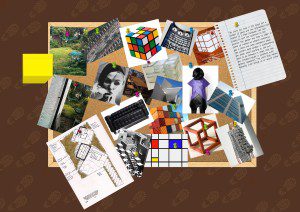What makes a good garden design? Some things to consider…

What makes a good garden design? It is important when you make the decision to landscape your garden that you consider your style. This sounds obvious but often when people attempt garden design they will try to marry many different styles and themes, throwing in as many ideas and objects as they can until they end up in a bit of a mess. If you follow these few simple steps, you will help define your preferences and tastes and hopefully end up with a coherent, balanced design.
1. Make a mood board.
Consider things which catch your eye. From fashion to music, architecture to cars, anything that has been designed or created can have an aesthetic appeal and be used as inspiration for your garden. Whether it is the latest dress from Vivienne Westwood or a cheese grater by Alessi, use items you find attractive to hone your taste. Ask yourself what items you like and why you like them. Pay a visit to your local museum, or if you live in London spend the day visiting the Design Museum or the Victoria and Albert museum (a couple of my faves.) Also consider the natural world for ideas. The diversity of wondrous things to be found in biology, geology, even cosmology, can be just as inspiring – if not more so – than anything mankind can conceive.
Wherever you find your inspiration, take photos when possible, or gather images from books, magazines and the internet, and assemble them on a board: you will soon start to see a relationship between them. If you are technologically minded you can use a graphics program such as Photoshop to make your mood board, but the old-fashioned cardboard, scissors and glue are just as good. Once you have assembled your mood board, look for common themes. It may be the shapes they form; are they predominantly soft and sinuous curves or bold geometric blocks? We tend to be drawn towards similar shapes when we analyse design-lead products in particular. Or your theme could be in the types of material you are attracted to. Perhaps you prefer synthetic materials such as steel or plastic, or instead are drawn towards natural substances like wood and stone. If you are considering redesigning your garden, spend at least a month in this planning stage, tuning yourself into aesthetic things that catch your eye and making your mood board the starting point to your creative process.
2. What’s my style?
It is rare that a garden is the first thing considered when someone starts renovating their property. In fact usually it is one of the last things that gets done, or even thought about. I always find this odd, as gardens, unlike interiors, actually often get better with age – plants grow bigger and more impressive and wood and stone features weather as the seasons pass. Whether you are tackling your garden first or last, what is really important is that the interior and exterior spaces have a relationship to each other. Look closely at your interior décor and furnishing. Most of the time your garden will work better if you try to stay true to this style – after all it is obviously what you like so you will find it easier to achieve something that looks well thought out. Keeping your style similar will also mean that the transition between house and garden will not be a culture shock. In my experience the only instance where different styles can work is if they are widely opposing, such as very impersonal and neutral interior with a wildly eccentric exterior. However, to achieve this you have to be very confident and well versed in design. Unless you really do feel that your vision for that formal Japanese garden will gel perfectly with your Laura Ashley living room, I think the best mantra would be ‘stick to what you know’…
3. Location Location Location…
Another important consideration, which is usually overlooked, is the garden’s surroundings. Nothing looks worse than a garden in the wrong setting. A grand colonnade with topiary in a terraced back yard will look naff and completely out of place, just as an uber-modern design next to a chocolate box cottage will seem clumsy and incongruous. Be aware of the age and style of your house. When was it built? What are its characteristics? Is there something you particularly like about your house? Or dislike? Play to its strengths.
One of the most jarring designs I ever completed was for a client whose house had been built in the 1960s. It was constructed from common red brick with white timber cladding around the upper storey and modern geometric windows. However the client loved Moroccan gardens, which are principally ornate with lots of colour and detailed floral and geometric patterns – pretty much the absolute antithesis of her house. I tried to drill down to what specifically she liked about Moroccan gardens, hoping there might be parts of her preferences we could dilute into something more suited to the style of her house. At one point she cited that she liked the cobalt blue that is prominent in gardens of this style and she liked the Mediterranean look, the terracotta, the planting. Some of the things she was describing reminded me of the poolside paintings by iconic 1960s painter, David Hockney. I wondered if this could be our hook – the paintings slick shapes and clean lines in strong pastels did, for me, speak of Mediterranean climes and would fit well against the house and boundary walls. Alas no – she wanted ornate mosaic tiling, an abundance of planting and wrought iron screens and furniture. Needless to say whilst the design was nice and certainly on brief, I am not sure it suited the space at all.
One of the challenges you often face as a designer is questioning someone’s preferences and helping them look at options in a different way, with a view to the bigger picture. Try to do this with your own garden and be flexible. Even if you have your heart set on a particular theme, be realistic about its suitability and be prepared to alter your ideas to match the surroundings. You may find that you will end up with a garden you grow to love more in the long run.
4. How long will I like this?
It is important to recognise that unlike interiors, gardens can be time-consuming and expensive to alter if you change your mind. Once you have decided on your style and its suitability you also need to consider its longevity. Will you still like this look in 5 or 10 years time? Or is it a fad that you may tire of quickly? If we get bored of our interior we simply hang new wallpaper or repaint the walls, however ripping up good decking to lay new paving, or ditching the architectural plants on favour of the cottage look, is more complex and you may need to decide when designing your garden if you can easily add to or adapt the space as your tastes or family circumstances change. If you think things may change then consider leaving space for new features or children’s play equipment, or select free standing features and ornamentation that can be replaced without too much fuss. Also be sure to plan for any future extensions to the property. If you intend to have a conservatory installed in a couple of years time, don’t stick an expensive patio or deck right where it is likely to go. Instead choose a cheaper, less permanent option, such as gravel, grass or artificial lawn.


